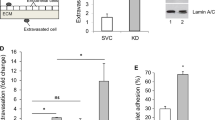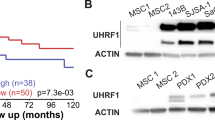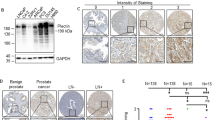Abstract
PRH/HHex (proline-rich homeodomain protein) is a transcription factor that controls cell proliferation and cell differentiation in a variety of tissues. Aberrant subcellular localisation of PRH is associated with breast cancer and thyroid cancer. Further, in blast crisis chronic myeloid leukaemia, and a subset of acute myeloid leukaemias, PRH is aberrantly localised and its activity is downregulated. Here we show that PRH is involved in the regulation of cell migration and cancer cell invasion. We show for the first time that PRH is expressed in prostate cells and that a decrease in PRH protein levels increases the migration of normal prostate epithelial cells. We show that a decrease in PRH protein levels also increases the migration of normal breast epithelial cells. Conversely, PRH overexpression inhibits cell migration and cell invasion by PC3 and DU145 prostate cancer cells and MDA-MB-231 breast cancer cells. Previous work has shown that the transforming growth factor-β co-receptor Endoglin inhibits the migration of prostate and breast cancer cells. Here we show that PRH can bind to the Endoglin promoter in immortalised prostate and breast cells. PRH overexpression in these cells results in increased Endoglin protein expression, whereas PRH knockdown results in decreased Endoglin protein expression. Moreover, we demonstrate that Endoglin overexpression abrogates the increased migration shown by PRH knockdown cells. Our data suggest that PRH controls the migration of multiple epithelial cell lineages in part at least through the direct transcriptional regulation of Endoglin. We discuss these results in terms of the functions of PRH in normal cells and the mislocalisation of PRH seen in multiple cancer cell types.
This is a preview of subscription content, access via your institution
Access options
Subscribe to this journal
Receive 50 print issues and online access
$259.00 per year
only $5.18 per issue
Buy this article
- Purchase on Springer Link
- Instant access to full article PDF
Prices may be subject to local taxes which are calculated during checkout





Similar content being viewed by others
References
Soufi A, Jayaraman PS . PRH/Hex: an oligomeric transcription factor and multifunctional regulator of cell fate. Biochem J 2008; 412: 399–413.
Topisirovic I, Culjkovic B, Cohen N, Perez JM, Skrabanek L, Borden KL . The proline-rich homeodomain protein, PRH, is a tissue-specific inhibitor of eIF4E-dependent cyclin D1 mRNA transport and growth. EMBO J 2003; 22: 689–703.
Swingler TE, Bess KL, Yao J, Stifani S, Jayaraman PS . The proline-rich homeodomain protein recruits members of the Groucho/Transducin-like enhancer of split protein family to co-repress transcription in hematopoietic cells. J Biol Chem 2004; 279: 34938–34947.
Guiral M, Bess K, Goodwin G, Jayaraman PS . PRH represses transcription in hematopoietic cells by at least two independent mechanisms. J Biol Chem 2001; 276: 2961–2970.
Denson LA, Karpen SJ, Bogue CW, Jacobs HC . Divergent homeobox gene hex regulates promoter of the Na(+)-dependent bile acid cotransporter. Am J Physiol Gastrointest Liver Physiol 2000; 279: G347–G355.
George A, Morse HC 3rd, Justice MJ . The homeobox gene Hex induces T-cell-derived lymphomas when overexpressed in hematopoietic precursor cells. Oncogene 2003; 22: 6764–6773.
McCormack MP, Young LF, Vasudevan S, de Graaf CA, Codrington R, Rabbitts TH et al. The Lmo2 oncogene initiates leukemia in mice by inducing thymocyte self-renewal. Science 2010; 327: 879–883.
Oram SH, Thoms JA, Pridans C, Janes ME, Kinston SJ, Anand S et al. A previously unrecognized promoter of LMO2 forms part of a transcriptional regulatory circuit mediating LMO2 expression in a subset of T-acute lymphoblastic leukaemia patients. Oncogene 2010; 29: 5796–5808.
Puppin C, Puglisi F, Pellizzari L, Manfioletti G, Pestrin M, Pandolfi M et al. HEX expression and localization in normal mammary gland and breast carcinoma. BMC Cancer 2006; 6: 192.
D'Elia AV, Tell G, Russo D, Arturi F, Puglisi F, Manfioletti G et al. Expression and localization of the homeodomain-containing protein HEX in human thyroid tumors. J Clin Endocrinol Metab 2002; 87: 1376–1383.
Jankovic D, Gorello P, Liu T, Ehret S, La SR, Desjobert C et al. Leukemogenic mechanisms and targets of a NUP98/HHEX fusion in acute myeloid leukemia. Blood 2008; 111: 5672–5682.
Topisirovic I, Guzman ML, McConnell MJ, Licht JD, Culjkovic B, Neering SJ et al. Aberrant eukaryotic translation initiation factor 4E-dependent mRNA transport impedes hematopoietic differentiation and contributes to leukemogenesis. Mol Cell Biol 2003; 23: 8992–9002.
Noy P, Gaston K, Jayaraman PS . Dasatinib inhibits leukaemic cell survival by decreasing PRH/Hhex phosphorylation resulting in increased repression of VEGF signalling genes. Leuk Res 2012; 36: 1434–1437.
Guerrero-Esteo M, Lastres P, Letamendia A, Perez-Alvarez MJ, Langa C, Lopez LA et al. Endoglin overexpression modulates cellular morphology, migration, and adhesion of mouse fibroblasts. Eur J Cell Biol 1999; 78: 614–623.
Quintanilla M, Ramirez JR, Perez-Gomez E, Romero D, Velasco B, Letarte M et al. Expression of the TGF-beta coreceptor endoglin in epidermal keratinocytes and its dual role in multistage mouse skin carcinogenesis. Oncogene 2003; 22: 5976–5985.
Bernabeu C, Conley BA, Vary CP . Novel biochemical pathways of endoglin in vascular cell physiology. J Cell Biochem 2007; 102: 1375–1388.
Liu Y, Jovanovic B, Pins M, Lee C, Bergan RC . Over expression of endoglin in human prostate cancer suppresses cell detachment, migration and invasion. Oncogene 2002; 21: 8272–8281.
Lakshman M, Huang X, Ananthanarayanan V, Jovanovic B, Liu Y, Craft CS et al. Endoglin suppresses human prostate cancer metastasis. Clin Exp Metastasis 2011; 28: 39–53.
Craft CS, Romero D, Vary CP, Bergan RC . Endoglin inhibits prostate cancer motility via activation of the ALK2-Smad1 pathway. Oncogene 2007; 26: 7240–7250.
Romero D, Terzic A, Conley BA, Craft CS, Jovanovic B, Bergan RC et al. Endoglin phosphorylation by ALK2 contributes to the regulation of prostate cancer cell migration. Carcinogenesis 2010; 31: 359–366.
Wong VC, Chan PL, Bernabeu C, Law S, Wang LD, Li JL et al. Identification of an invasion and tumor-suppressing gene, Endoglin (ENG), silenced by both epigenetic inactivation and allelic loss in esophageal squamous cell carcinoma. Int J Cancer 2008; 123: 2816–2823.
Perez-Gomez E, Villa-Morales M, Santos J, Fernandez-Piqueras J, Gamallo C, Dotor J et al. A role for endoglin as a suppressor of malignancy during mouse skin carcinogenesis. Cancer Res 2007; 67: 10268–10277.
Henry LA, Johnson DA, Sarrio D, Lee S, Quinlan PR, Crook T et al. Endoglin expression in breast tumor cells suppresses invasion and metastasis and correlates with improved clinical outcome. Oncogene 2011; 30: 1046–1058.
Nakagawa T, Abe M, Yamazaki T, Miyashita H, Niwa H, Kokubun S et al. HEX acts as a negative regulator of angiogenesis by modulating the expression of angiogenesis-related gene in endothelial cells in vitro. Arterioscler Thromb Vasc Biol 2003; 23: 231–237.
Berthon P, Cussenot O, Hopwood L, Leduc A, Maitland N . Functional expression of sv40 in normal human prostatic epithelial and fibroblastic cells—differentiation pattern of nontumorigenic cell-lines. Int J Oncol 1995; 6: 333–343.
Lang SH, Sharrard RM, Stark M, Villette JM, Maitland NJ . Prostate epithelial cell lines form spheroids with evidence of glandular differentiation in three-dimensional Matrigel cultures. Br J Cancer 2001; 85: 590–599.
Desjobert C, Noy P, Swingler T, Williams H, Gaston K, Jayaraman PS . The PRH/Hex repressor protein causes nuclear retention of Groucho/TLE co-repressors. Biochem J 2009; 417: 121–132.
Soufi A, Smith C, Clarke AR, Gaston K, Jayaraman PS . Oligomerisation of the developmental regulator proline rich homeodomain (PRH/Hex) is mediated by a novel proline-rich dimerisation domain. J Mol Biol 2006; 358: 943–962.
Pimanda JE, Chan WY, Donaldson IJ, Bowen M, Green AR, Gottgens B . Endoglin expression in the endothelium is regulated by Fli-1, Erg, and Elf-1 acting on the promoter and a −8-kb enhancer. Blood 2006; 107: 4737–4745.
Pimanda JE, Chan WY, Wilson NK, Smith AM, Kinston S, Knezevic K et al. Endoglin expression in blood and endothelium is differentially regulated by modular assembly of the Ets/Gata hemangioblast code. Blood 2008; 112: 4512–4522.
Noy P, Williams H, Sawasdichai A, Gaston K, Jayaraman PS . PRH/HHex controls cell survival through coordinate transcriptional regulation of VEGF signalling. Mol Cell Biol 2010; 30: 2120–2134.
Guo Y, Chan R, Ramsey H, Li W, Xie X, Shelley WC et al. The homeoprotein Hex is required for hemangioblast differentiation. Blood 2003; 102: 2428–2435.
Botella LM, Sanchez-Elsner T, Rius C, Corbi A, Bernabeu C . Identification of a critical Sp1 site within the endoglin promoter and its involvement in the transforming growth factor-beta stimulation. J Biol Chem 2001; 276: 34486–34494.
Sanchez-Elsner T, Botella LM, Velasco B, Langa C, Bernabeu C . Endoglin expression is regulated by transcriptional cooperation between the hypoxia and transforming growth factor-beta pathways. J Biol Chem 2002; 277: 43799–43808.
Botella LM, Sanchez-Elsner T, Sanz-Rodriguez F, Kojima S, Shimada J, Guerrero-Esteo M et al. Transcriptional activation of endoglin and transforming growth factor-beta signaling components by cooperative interaction between Sp1 and KLF6: their potential role in the response to vascular injury. Blood 2002; 100: 4001–4010.
Williams H, Jayaraman PS, Gaston K . DNA wrapping and distortion by an oligomeric homeodomain protein. J Mol Biol 2008; 383: 10–23.
Noy P, Sawasdichai A, Jayaraman PS, Gaston K . Protein kinase CK2 inactivates PRH/Hhex using multiple mechanisms to de-repress VEGF-signalling genes and promote cell survival. Nucleic Acids Res 2012; 40: 9008–9020.
Kassouf W, Ismail HR, Aprikian AG, Chevalier S . Whole-mount prostate sections reveal differential endoglin expression in stromal, epithelial, and endothelial cells with the development of prostate cancer. Prostate Cancer Prostatic Dis 2004; 7: 105–110.
Oxmann D, Held-Feindt J, Stark AM, Hattermann K, Yoneda T, Mentlein R . Endoglin expression in metastatic breast cancer cells enhances their invasive phenotype. Oncogene 2008; 27: 3567–3575.
Schneider CA, Rasband WS, Eliceiri KW . NIH Image to ImageJ: 25 years of image analysis. Nat Methods 2012; 9: 671–675.
Ma C, Wang XF . In vitro assays for the extracellular matrix protein-regulated extravasation process. CSH Protocols 2008;. pdb prot5034.
Soufi A, Noy P, Buckle M, Sawasdichai A, Gaston K, Jayaraman PS . CK2 phosphorylation of the PRH/Hex homeodomain functions as a reversible switch for DNA binding. Nucleic Acids Res 2009; 37: 3288–3300.
Acknowledgements
We are grateful to Professor Norman J Maitland (University of York) for PNT2-C2 cells and useful discussions, Professor Kate Nobes (University of Bristol) for access to live cell imaging, Professor Clare Isacke (Institute of Cancer Research) for the Endoglin expression vector, Professor Harry Mellor (University of Bristol) and Professor Roy Bicknell (University of Birmingham) for HUVECs and useful discussions, and Professor Carmelo Bernabeu (Centro de Investigaciones Biologicas, Madrid) for Endoglin-luciferase reporter constructs. We are grateful to Laura A V Rodriguez and Xin Yang for technical assistance. This work was funded by a Breast Cancer Campaign project grant to PSJ and KG. YHS is grateful to the University of Bristol for a PhD Scholarship and to the Charles Wallace Pakistan Trust for additional support. DR is grateful to the MRC for a PhD studentship.
Author information
Authors and Affiliations
Corresponding author
Ethics declarations
Competing interests
The authors declare no conflict of interest.
Additional information
Supplementary Information accompanies this paper on the Oncogene website
Supplementary information
Rights and permissions
About this article
Cite this article
Kershaw, R., Siddiqui, Y., Roberts, D. et al. PRH/HHex inhibits the migration of breast and prostate epithelial cells through direct transcriptional regulation of Endoglin. Oncogene 33, 5592–5600 (2014). https://doi.org/10.1038/onc.2013.496
Received:
Revised:
Accepted:
Published:
Issue Date:
DOI: https://doi.org/10.1038/onc.2013.496
Keywords
This article is cited by
-
CENPA knockdown restrains cell progression and tumor growth in breast cancer by reducing PLA2R1 promoter methylation and modulating PLA2R1/HHEX axis
Cellular and Molecular Life Sciences (2024)
-
CK2-induced cooperation of HHEX with the YAP-TEAD4 complex promotes colorectal tumorigenesis
Nature Communications (2022)
-
Hhex inhibits cell migration via regulating RHOA/CDC42-CFL1 axis in human lung cancer cells
Cell Communication and Signaling (2021)
-
Hyperglycaemia up-regulates placental growth factor (PlGF) expression and secretion in endothelial cells via suppression of PI3 kinase-Akt signalling and activation of FOXO1
Scientific Reports (2021)
-
Blood platelets stimulate cancer extravasation through TGFβ-mediated downregulation of PRH/HHEX
Oncogenesis (2020)



